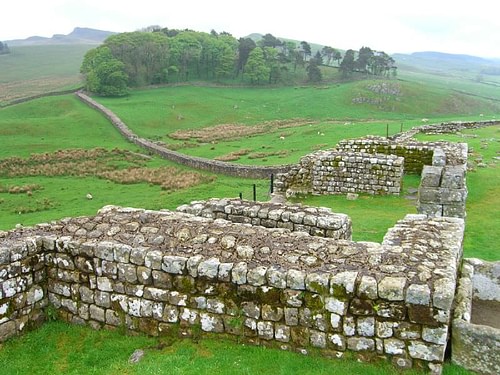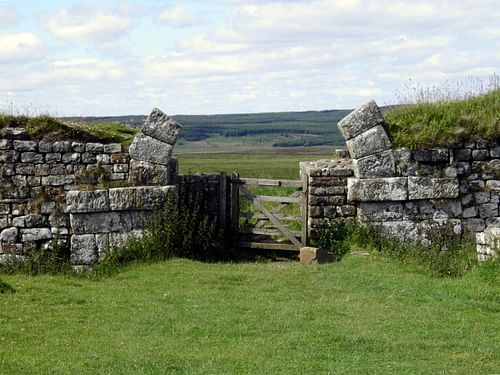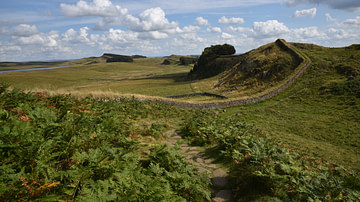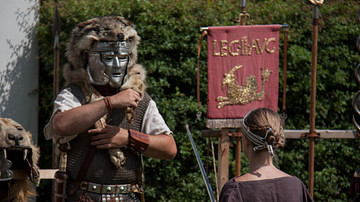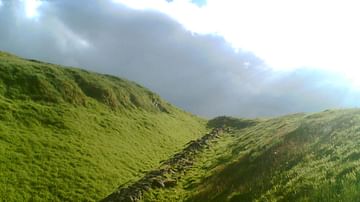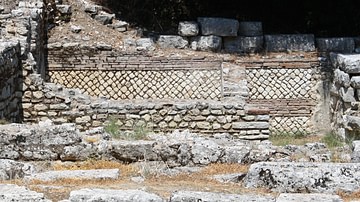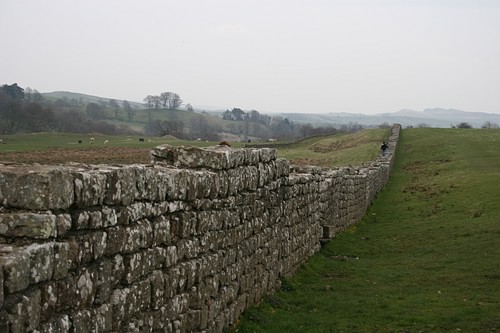
Hadrian's Wall (known in antiquity as the Vallum Hadriani or the Vallum Aelian) is a defensive frontier work in northern Britain which dates from 122 CE. The wall ran from coast to coast at a length of 73 statute miles (120 km). Though the wall is commonly thought to have been built to mark the boundary line between Britain and Scotland, this is not so; no one knows the actual motivation behind its construction but it does not delineate a boundary between two countries.
While the wall did simply mark the northern boundary of the Roman Empire in Britain at the time, theories regarding the purpose of such a massive building project range from limiting immigration, to controlling smuggling, to keeping the indigenous people at bay north of the wall. The wall continued in use until it was abandoned in the early 5th century CE.
Purpose
The military effectiveness of the wall has been questioned by many scholars over the years owing to its length and the positioning of the fortifications along the route. The argument goes that, had the wall actually been built as a defensive barrier, it would have been constructed differently and at another location. Regarding this, Professors Scarre and Fagan write,
Archaeologists and historians have long debated whether Hadrian's Wall was an effective military barrier…Whatever its military effectiveness, however, it was clearly a powerful symbol of Roman military might. The biographer of Hadrian remarks that the emperor built the wall to separate the Romans from the barbarians. In the same way, the Chinese emperors built the Great Wall to separate China from the barbarous steppe peoples to the north. In both cases, in addition to any military function, the physical barriers served in the eyes of their builders to reinforce the conceptual divide between civilized and noncivilized. They were part of the ideology of empire. (Ancient Civilizations, 313)
This seems to be the best explanation for the underlying motive behind the construction of Hadrian's Wall. The Romans had been dealing with uprisings in Britain since their conquest of the region. Although Rome's first contact with Britain was through Julius Caesar's expeditions there in 55/54 BCE, Rome did not begin any systematic conquest until the year 43 CE under the Emperor Claudius (r. 41-54 CE).
The revolt of Boudicca of the Iceni in 60/61 CE resulted in the massacre of many Roman citizens and the destruction of major cities (among them, Londinium, modern London) and, according to the historian Tacitus (56-117 CE), fully demonstrated the barbaric ways of the Britons to the Roman mind.
Boudicca's forces were defeated at The Battle of Watling Street by General Gaius Suetonius Paulinus in 61 CE. At the Battle of Mons Graupius, in the region which is now Scotland, the Roman General Gnaeus Julius Agricola won a decisive victory over the Caledonians under Calgacus in 83 CE. Both of these engagements, as well as the uprising in the north in 119 CE (suppressed by the Roman governor and general Quintus Pompeius Falco), substantiated that the Romans were up to the task of managing the indigenous people of Britain.
The suggestion that Hadrian's Wall, then, was built to hold back or somehow control the people of the north does not seem as likely as that it was constructed as a show of force. Hadrian's foreign policy was consistently “peace through strength” and the wall would have been an impressive illustration of that principle. In the same way that Julius Caesar built his famous bridge across the Rhine in 55 BCE simply to show that he, and therefore Rome, could go anywhere and do anything, Hadrian perhaps had his wall constructed for precisely the same purpose.
Origin and Construction
Hadrian (born Publius Aelius Hadrianus, l. 76-138 CE, r. 117-138 CE) was among the most "hands-on" emperors in the history of the Roman Empire. Hadrian visited almost every province of the empire during his reign and personally inspected and approved of the sites he wanted used for his projects. He came to Britain in 122 CE and was hosted in the north by the governor Falco with whom he would have toured the region of the wall whose construction, possibly, had already begun.
Hadrian's building projects, especially in Greece, are legendary and his penchant for ambitious monuments is exemplified in his eponymous wall. The work was begun in stone (unlike other fortifications which began with timber) in the east and proceeded westward across uneven terrain to create an impressive reflection of the power of Rome.
The wall was originally 9.7 feet wide (3 metres) and 16-20 feet high (six metres) east of the River Irthing, all built of stone, and 20 feet wide (6 metres) by 11feet high (3.5 metres) west of the river, made up of stone and turf, stretching 73 miles (120 km) across the breadth of the land. This ambitious building project was completed within six years through the labour of the Roman legions stationed in Britain. Plans for the construction of the wall were in place prior to Hadrian's visit to Britain in 122 CE and, perhaps, construction had already begun before the traditional date assigned for the initial work on the wall, possibly as early as 118 CE.
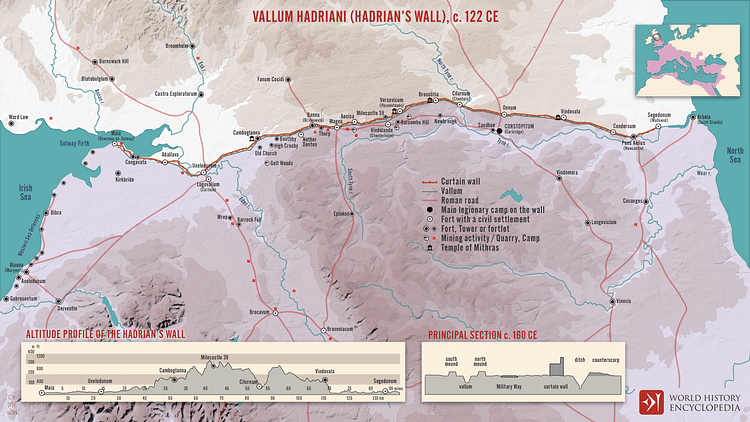
Defensive Fortifications
There were between 14-17 fortifications along the length of the wall and a Vallum (a ditch purposefully constructed of earthworks) which ran parallel to the wall. The Vallum measured 20 feet (6 metres) wide by 10 feet (3 metres) deep, flanked by large mounds of tightly packed earth. It is this composition of the site which has given rise to the traditional interpretation of the wall as a defensive work built to repel invasion from the north. These fortifications were garrisoned with Roman troops and it has been established that these soldiers did interact with the natives of the frontier in skirmishes. Scholar Nigel Rodgers comments:
About 15,000 auxiliaries were deployed along or around the wall. Most were not strung out along it but concentrated in camps for 500 or 1,000 men, such as Housesteads, from which they issued forth to deal with intruders. The wall was not a hermetic frontier but controlled traffic and impressed natives. Forts like High Rochester, 30 miles (48 km) north, provided advance posts, while strong reinforcements could be summoned from the legionary fortress at York to the south. (177)
Clearly, then, there was a defensive aspect to the wall but that still does not seem to have been its primary purpose. The construction of the Vallum does not even seem to have built for defensive purposes. Scholars Lesley and Roy A. Adkins note that the Vallum "probably served as a boundary marker, keeping civilians away" (98). This claim is in keeping with the growing scholarly consensus that the wall was actually conceived of as more of a symbolic gesture, a dramatic statement of Rome's power, than a line of defense or a means of seriously limiting illegal immigration.
Hadrian's and Antonine Wall
The Vallum was built after the construction of the wall and the forts as evidenced by its deviation from existing ruins and the clear indication of causeways across the ditch at intervals which correspond to established fortification sites. When the Antonine Wall was constructed further north (in c. 142 CE by Emperor Antoninus Pius) the Vallum appears to have been partially filled in for easier passage. The Antonine Wall was built after Hadrian's Wall had been abandoned as an outpost and was positioned further to the north in present-day Scotland between the Firth of Forth and the Firth of Clyde.
The Antonine Wall was perhaps constructed to serve the same purpose as Hadrian's Wall but is thought to have functioned more pragmatically than the earlier construct. Hadrian's Wall is thought to have been plastered and white washed so that it would be a shining beacon of the might of Rome, visible from considerable distances. The Antonine Wall does not suggest this same grandeur nor, in spite of the many fortifications along its route, the same intent in design and construction.
Emperor Marcus Aurelius (r.161-180 CE) drew the Roman legions back from the Antonine Wall to Hadrian's Wall under his reign and fortified the garrisons in his efforts to maintain the boundaries of the Empire. Hadrian's great monument to Rome's might continued as an impressive affirmation until 410 CE when the Roman legions left Britain. Activity around and along the wall seems to have continued as evidenced by archaeological finds but a disciplined Roman presence after 410 CE is not signified along either wall nor throughout Britain as a whole.
Conclusion
Following the Roman withdrawal, large portions of the wall were carried off for personal building projects by the local inhabitants but the ruins of the wall seem to have been used by Briton forces who garrisoned it. In the 6th and 7th centuries CE, stones from the wall were used as far off as the Kingdom of Northumbria and some appear in the Monkwearmouth-Jarrow Abbey. The wall continued to be dismantled for other projects in the centuries which followed. Huge sections were removed to provide paving for British troops heading north on muddy tracks to quell the Jacobite Uprising of 1745 CE.
Hadrian's Wall may have disappeared entirely were it not for the efforts of one man, the antiquarian John Clayton (1792-1890 CE) who, in 1834 CE, began buying the land around the wall in an effort to preserve it. Clayton's excavations and enthusiasm for the site kept what remains of Hadrian's Wall intact and, in 1987 CE, it was declared a World Heritage Site by UNESCO. Today it is under the care of English Heritage commission and is cared for largely by volunteers who recognize its immense historical significance.
